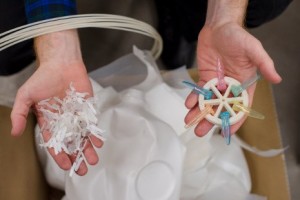We all know that 3D printing is the most cost-effective option when it comes to manufactured products and now scientists claim that the already low cost for 3D printed products can dive further down with the option to produce your own plastic filament from recycled milk jugs.

According to a news article featured on Michigan Tech, a study led by Joshua Pearce, an associate professor of materials science and engineering and electrical and computer engineering at Michigan Technological University, has shown that making your own plastic 3D printer filament from milk jugs uses much less energy than recycling milk jugs conventionally.
The study, “Life-Cycle Analysis of Distributed Recycling of Post-consumer High Density Polyethylene for 3-D Printing Filament,” by Megan Kreiger, Meredith Mulder, Alexandra Glover and Pearce, all of Michigan Tech, was published on February 12th in the Journal of Cleaner Production.
Their process of turning milk jugs into filament at home uses 3% less energy in comparison with the ideal urban recycling program which collects and processes plastic locally.
“Where it really shows substantial savings is in smaller towns like Houghton, where you have to transport the plastic to be collected, then again to be recycled, and a third time to be made into products,” said Pearce.
Pearce further compared the cost of making your own filament with buying commercial variants that usually cost under $300.
“Filament is retailing for between $36 and $50 a kilogram, and you can produce your own filament for 10 cents a kilogram if you use recycled plastic. There’s a clear incentive, even if you factor in the cost of buying the RecycleBot.”
The Ethical Filament Foundation has shown great interest in this new type or recycling technology and now intends to improve the lives of people who pick waste.
“In the developing world, it’s hard to get filament, and if these recyclers could make it and sell it for, say, $15 a kilogram, they’d make enough money to pull themselves out of poverty while doing the world a lot of good,” he said.
To read the full study, go to https://www.academia.edu/6188555/Life_cycle_analysis_of_distributed_recycling_of_post-consumer_high_density_polyethylene_for_3-D_printing_filament




















